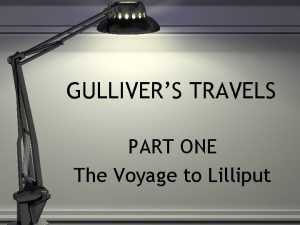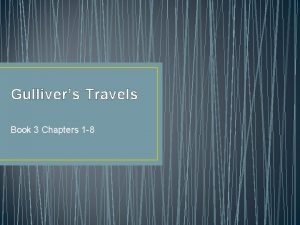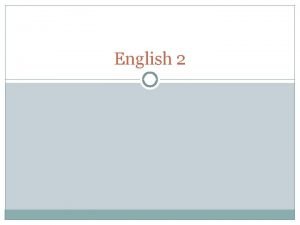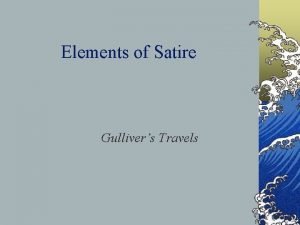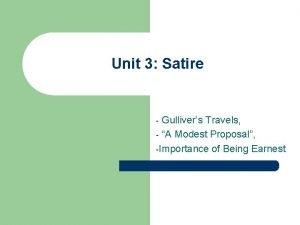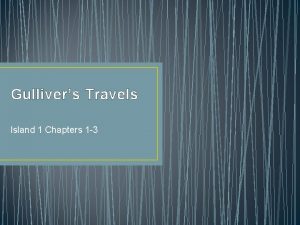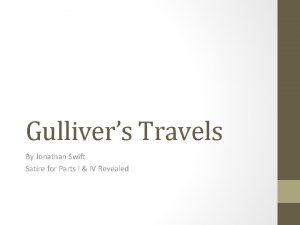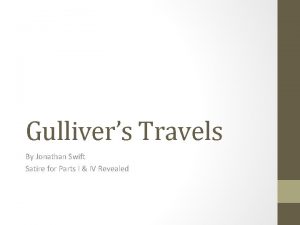Satire in Gullivers Travels Gullivers Travels a satirical








- Slides: 8

Satire in Gulliver’s Travels

Gulliver’s Travels: a satirical approach • Jonathan Swift’s “Gulliver’s travels” appears to be a travel log, made to chronicle the adventures of a man, Lemuel Gulliver, on the four most incredible voyages imaginable. • Primarily, however, Gulliver's Travels is a work of satire as Gulliver is neither a fully developed character nor even an altogether distinguishable persona; rather, he is a satiric device enabling Swift to score satirical points. • Besides, in order to convey this satire, Gulliver is taken on four adventures, driven by fate, a restless spirit, and the pen of Swift.

What is Satire? How it is injected into the plot? • Satire pokes fun at social problems and human weaknesses, often using exaggeration. • Swift ties his satire closely with Gulliver's perceptions and adventures. • As Swift leads Gulliver on these four fantastical journeys, Gulliver's perceptions of himself and the people and things around him change, giving Swift ample opportunity to inject into the story both irony and satire of the England of his day and of the human condition.

Part 1: a little summary In Gulliver's first adventure, he begins on a ship that runs aground on a submerged rock. He swims to land, and when he awakens, he finds himself tied down to the ground, and surrounded by tiny people, the Lilliputians. The Lilliputians relate to him the following story that in Lilliput, years ago, people once broke eggs on the big end. However, the present king's grandfather once cut himself breaking the egg in this manner. Here, irony is present from the start in the simultaneous recreation of Gulliver as giant and prisoner. So the King at the time, the father of the present king's grandfather, issued an edict that all were to break the eggs on the small end. Gulliver is surprised at the intrepidity of these diminutive mortals, who dare venture to mount and walk upon his body, but he admires this quality in them. Some of the people resisted, and they found refuge in Blefuscu, and for six and thirty moons past the two sides have been at war.

Part 1: Satirical approach • Thus in Gulliver's Travels, Swift pokes fun at the human tendency to equate physical beauty with moral beauty and physical ugliness with being a morally bad person. The tiny, dainty, pretty Lilliputians seem doll-like and good at first but turn out to be petty, nasty, cruel, and vindictive people who focus on trivial things. • For Swift, Lilliput is analogous to England, and Blefuscu to France. With this event of the story Swift satirizes the needless bickering and fighting between the two nations.

Part 4: a little summary • In this journey, Gulliver comes to the land of the Houyhnhnms, which are creatures that look like horses but have the ability to reason. • Swift brings Gulliver into contact with a Yahoo once again and Gulliver finds the difference between himself and Yahoo. • Also, in this land are the Yahoos, of which Gulliver could only say that upon the whole, he never beheld in all his travels so disagreeable an animal, nor one against which he naturally conceived so strong an antipathy. • Indeed, Gulliver finds that the only difference between himself and the Yahoo to be the Yahoo's lack of cleanliness and clothes; otherwise, a Yahoo would be indistinguishably human.

Part 4: Satirical approach • In part 4, Swift's satire achieves its goal, and shows that the flaws of humanity are overwhelming, and let to continue, result in a total degradation of the humans. • As the “visited society" has an effect on Gulliver, he no longer can be said to function as a constant or impartial measure, however, this is the point that Gulliver's perceptions change, and so do his narrations, as a result, and through this Swift can convey his satire and social commentary.

Conclusion • Taken on four voyages, Gulliver's ultimate travels are to a greater understanding of human nature and its flaws. • After the first voyage, his image of humanity is little changed, likewise for the 2 nd, although after this point, Gulliver's image steadily declines until the fourth voyage, when he meets the Yahoos. In this way, Swift presents his commentary on the human condition through Gulliver's Travels.

